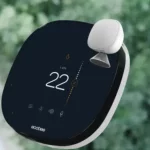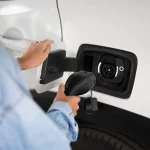But with the right information and a little planning, installing solar panels on your house doesn’t have to be taxing – and that’s where this article comes in!
In this complete guide, we’ll run through all the points you need to keep in mind when deciding how many solar panels you need in the UK. We’ll explain how you can work out the right number of panels for you, offering tips on calculating your energy consumption and how to take space, efficiency, and budget into account. So, let’s get to it!
TL;DR
If you’re short on time, here are the most important things you need to know:
- When you’re determining the number of solar panels you need, the most important thing to take into account is your annual electricity usage.
- Your panel efficiency can be affected by anything from roof size and orientation to the amount of shade on your roof.
- Your geographical location will affect sunlight exposure – and, therefore, the output of your panels.
- There’s different types of solar panels available, each with different efficiency levels.
- Government grants are available to help offset your installation costs.
- Proper installation and regular maintenance are essential if you want to get the best possible performance.
Assessing Your Energy Consumption
If you’re taking your first steps towards installing solar panels on your house, one of the first things you’ll need to figure out is exactly how many panels you need. And one of the keys to working that out is calculating your energy consumption.
When you determine the average amount of energy you’re likely to use on any given day, you’ll get a baseline figure that’ll help you estimate how many panels you’ll need to meet that demand. But unfortunately, energy consumption isn’t a one-size-fits-all situation! Your total energy consumption can depend on the size of your house, how many people live in it, the appliances you use, and even your lifestyle. So, how exactly can you work out your energy consumption?
Calculating Annual Energy Usage
If you’re looking for a ballpark estimate, there are some average figures that can help you plan out your solar panel needs. For instance, an average 2/3-bedroom house in the UK uses around 2,700 kilowatt hours (kWh) each year, and that would mean 9/10 350W panels.
But what about if you have more people living in your house or you use a few power-hungry appliances? In truth, we all have unique energy requirements – and that’s why it’s important to figure out your individual energy usage. Thankfully, it’s pretty straightforward to work out your usage using only your energy bill or your supplier’s online portal! Just follow these steps:
- Collect your recent energy bills, ideally for the last 12 months.
- Add together the total kWh on each of these bills – that’s your annual energy usage!
If you don’t have 12 months’ worth of bills, don’t worry. You’ll still be able to see your monthly energy requirements, which should give you enough information to decide how many panels you need. And if you have a few bills from different times of the year to hand, representing how your energy needs fluctuate throughout the year, you might even be able to estimate your annual requirements too.
Estimating Future Energy Needs
When you’re working out your solar panel needs, don’t forget about the future! You might use, say, 3,000 kWh of energy right now, but what if your needs grow? Maybe you’d like to give your renewable energy efforts a boost later on with a heat pump. Perhaps you’ll make the switch to an electric car, which can add around 1,300 kWh to your annual energy usage. Or maybe you just like the sound of relaxing in a hot tub! Any of these things will see your energy usage bump up a pretty healthy amount.
You can add to your solar PV system later, but it’s cheaper to get it right the first time! So, if your needs are likely to change in the years to come, remember to take that into account.
Using Energy Calculators
If you’re looking for a more precise estimate of your energy requirements or just want to double-check your calculations, you need an online solar energy calculator! These nifty tools, like the Soly Online Configurator, are a great way to get a more accurate read on exactly how many panels you’re going to need.
Beyond your annual energy usage, online calculators take into account extra details, like your geographical location, roof size and orientation, level of shade, and panel efficiency. Together, these details can paint a clear picture of just how big your system will need to be to cope with everything you’ll throw at it!
Evaluating Roof Characteristics
So, once you’ve got a grip on your energy usage, you just need to buy enough panels to cover the kWh needs, right? Unfortunately, we’re not there just yet! There’s a few more things that you need to take into account, starting with your roof.
When it comes to solar panel on roof installations, it’s not always a matter of how many panels you fit – it’s just as important to consider how and where they go too. By paying close attention to the size and orientation of your roof, along with avoiding areas likely to spend plenty of time in the shade, you can give yourself the best chance of ramping up your panel efficiency.
Roof Size and Usable Area
Once you know how many panels you’re going to need, it’s pretty important to make sure you can fit them all on your roof! What’s more, depending on the panels you choose, you might need to take into account the connections of solar modules too. To do so, you’ll need to find an approximate measurement of your roof. That sounds a little scary, but thankfully, you won’t need to scale your house to find this out.
Going hand-in-hand with roof size is your total usable area. As the name suggests, this is the amount of space on your roof that you can actually put solar panels on. Of course, it’d be amazing if you could just fill your entire roof with panels! But unfortunately, thanks to things like chimneys, vents, and dormer windows, that’s unlikely to be the case.
To quickly estimate your roof space, start by measuring the total area of your upper floor. Then, multiply that figure by 1.2. Finally, remember to make rough deductions for things like chimneys and dormers, and you’ll be left with an approximate amount of roof space to play with.
Roof Orientation and Angle
As well as roof size, orientation and angle are also important factors in your quest for panel efficiency. Both of these elements can have a pretty big impact on the output of your panels, so if your roof doesn’t come close to the ideal settings, you might need a few more panels to compensate.
The UK is in the northern hemisphere, so south-facing roofs get the most exposure to sunlight. As such, that’s the side of your roof you’ll want to install your panels on for maximum energy generation. There’s a little more wiggle room when it comes to pitch; you can achieve fair results anywhere from 20° to 50°. That said, you’ll find the very best results at around 35°, so the closer your roof pitch is to that angle, the better.
Shading and Obstructions
It stands to reason, but if you have any obstructions stopping precious sunlight from hitting your roof, then you’re going to experience a drop in efficiency from your solar panels. So, when you’re calculating your panel needs, think about any obstructions that could impact your performance. That could be a chimney, a nearby building or tree, or simply shading that falls on your roof.
Geographical Location and Sunlight Exposure
Aside from factors unique to your property, like nearby obstructions, the efficiency of your panels can also vary depending on exactly where in the UK you live. Panels are more effective in sunnier areas, generating more energy than the same panel in less sunny climates. So, if you live down south, say in Cornwall or the South East, you’ll benefit from a higher panel output than you would if you lived further up north in northern England or Scotland. It’s important to keep in mind that solar panels still work quite well in cloudy weather.
Installing panels is a fairly significant investment, and it’s important to make sure you’re going to benefit from shelling out on the cost of solar panels. So, before you put panels on your roof, remember to check your local solar irradiance levels before deciding on the size of your solar system. For accurate information on your region, check out one of the resources available online to find out how much sun you’re likely to get.
Don’t forget, the sunlight you’ll receive in your location is also subject to change throughout the year. With summer offering more daylight hours than winter, you’ll find your panels produce more energy when they can enjoy longer days. When you’re working out your panel needs, it’s important to take this redundancy into account too.
Selecting the Right Type of Solar Panels
Once you’re comfortable with your energy usage needs and you’ve got a handle on how your location, roof, and any nearby obstructions could affect you, it’s time to start thinking about panels. Panels come in different types and sizes. And depending on your energy needs and physical limitations, you might find that some could work better for you than others.
Let’s explore the most common panel options you can choose from:
- Monocrystalline Panels: Monocrystalline panels are the most efficient type of panel available right now (This is the type of panels that Soly utilises). With an efficiency range of between 18% and 24%, they’re perfect if you need the highest possible efficiency because of limited roof space or a suboptimal geographical location.
- Polycrystalline Panels: While a little less efficient (between 13% – 16%), these panels are a cheaper option than monocrystalline panels. If you have a bigger roof to work with, polycrystalline panels could be a more cost-effective solution.
- Thin-film Panels: If you want the ultimate cost-saving panel option, then thin-film panels could be what you’re looking for. However, despite their lower price point, they also have the worst efficiency, in some cases as low as 7%.
Of course, panel choice doesn’t solely come down to efficiency and cost. Some panels offer better savings on carbon emissions than others. So, if you’re trying to keep your carbon footprint as low as possible, it’s worth doing a little research to find the panels that offer the best environmental benefits.
Keep on reading: Pros and cons of solar panels
Financial Considerations and Incentives
Despite the incredible benefits, there will be unavoidable costs involved in switching your home to solar power. That said, there are also financial incentives available that you might be able to take advantage of, bringing your costs down. If you’re considering installing panels, it’s important that you take all the costs into account before making your decision, so let’s spend some time looking at all the facts and figures.
Cost of Solar Panels
The cost of installing panels depends a huge amount on exactly how big your house is and how many panels you need. In total, your bill will include the cost of panels, additional components, like a battery and inverter, and all labour costs. In 2024, the average installation cost is around £8,500 – £9,100.
Once your panels are up and running, you’ll start to see savings on your energy bill, lasting for the lifespan of your panels. So, is it worth getting solar panels? That depends on whether you’re prepared to make an initial outlay in return for long-term reductions on your energy bill.
Government Grants and Loans
It’s worth noting that you might not need to face the cost of installing panels by yourself! With government-run schemes like the Green Homes Grant, the Smart Export Guarantee (SEG), and the Energy Company Obligation Scheme (ECO4), you may qualify for a grant or loan that can cut your initial costs down by a substantial amount.
While there are some requirements to qualify for these schemes, they’re typically widely available and have helped plenty of people make the switch to solar.
Installation and Maintenance
As with any other home improvement, correct installation and proper maintenance are a must if you want to make the most of your investment. In this section, we’ll take a closer look at the installation process and share a few tips on finding the right installer and how you can maintain your panels.
Installation Process
Getting the best out of your solar panels starts with proper installation. Before a panel touches your roof, there’s a few initial steps that you’ll need to take with your chosen installer to guarantee suitability and correct mounting. Fortunately, when you pick Soly as your panel provider, getting started is as simple as a few clicks.
To get the ball rolling, visit the Soly Solar Configurator. After entering your address and answering a few questions about your roof and annual electricity usage, you’ll be able to quickly find your recommended number of panels. More than that, you’ll also discover your potential solar yield, your estimated payback period, and just how much you can save each year.
Once you’ve received this information, you can chat with a Soly Solar Expert to get your free no-obligation quote. Then, if you’re happy with the numbers and wish to proceed, it’s time to book a consultation with one of our friendly and knowledgeable representatives.
Before the actual installation begins, your roof should be inspected for suitability. If there’s any structural weakness, that should be addressed first before you add the weight of your solar system. Next, it’s worth checking whether you’ll need a permit to carry out the work. Generally speaking, you don’t need planning permission to add panels to your roof. However, if you live in a listed building or your home is in a conservation area, it might be worth checking with your local planning authority.
Once those steps are out of the way, the installation process can begin. Of course, your panels need to be safely mounted. So, depending on your roof, if you have slate tiles, for instance, you might need a specialised solar panel mounting system.
Choosing an Installer
Finding a good and reliable solar panel installer is crucial, so think about all the same things you would do for any other home improvement work, such as if you were looking for a window fitter or bricklayer. Correct certification is a must, so look for fitters who are MCS-certified. And when you pick Soly, you can rest assured that your installer will be reputable, certified, and have plenty of experience. Soly also underwent rigorous assessment to qualify as a Which? Trusted Trader, a certification which signals our high quality service and products.
Also, it’s always worth checking customer reviews – looking out for other people’s success stories could help you find the perfect installer for your needs!
Maintenance Best Practices
Once your shiny new panels are installed, you’ll want to ensure they stay in top condition. By following a few simple maintenance steps, you can keep them working at their best for years to come.
When it comes to a typical solar panel, the most important step for maintaining performance is keeping them clean. In general, you’ll need to clean your panels every six months. But when you choose Soly, you won’t receive typical solar panels! In fact, our panels don’t require any cleaning whatsoever. That means no climbing on your roof and wiping your panels to maintain the same performance levels.
So, without the need to clean, are there any other steps you need to take to preserve our solar yield? Well, it’s also worth occasionally inspecting them to monitor system performance. That means checking your day-to-day performance and noting down energy production for signs of degradation. Customers are able to monitor their system’s performance through their system’s app. Rest assured, the installers that Soly works with will help them get set up on the app that works with their system after the installation is complete.
Finally, consider visually inspecting components like inverters from time to time, just to make sure they’re performing as expected.
Common Questions
Installing solar panels is a big decision, and there’s plenty to think about before you go ahead. Let’s take a look at some of the most common questions people have about installing solar panels in the UK.
How many solar panels does a typical UK home need?
When it comes to one of the first questions that many people ask, how many panels do I need, UK house size can make all the difference. There’s a huge range in property size in this country, so the amount of panels you need can greatly vary. That said, for the average two or three-bedroom house using 350W panels, you’ll typically need 9/10 panels.
Beyond your house size, remember that your individual needs may mean you need more (or fewer) panels. For instance, if you have a lot of power-hungry appliances or a high occupancy, you may need a few extra panels to cope with the increased power needs.
Do solar panels work in winter?
Yes, solar panels are still effective in cooler temperatures, so as long as you have daylight, they will still work in winter. However, given the shorter days, you might notice that your panels generate less electricity than they do in summer.
Can I sell excess electricity back to the grid?
Yes! Thanks to the Smart Export Guarantee (SEG), one of the great benefits of solar panels is any excess energy you generate can be sold to the National Grid. As a result, you can offset your energy costs – and maybe even generate some additional income.
What is the lifespan of solar panels?
Generally speaking, solar panels will last for around 25-30 years. If you’re prepared to push the boat out a little more, you can choose to splash out on high-quality panels that can last for as much as 50 years. But whichever panels you buy, regular maintenance is key to maximising their lifespan.
Do I need planning permission to install solar panels?
In most cases, no, you shouldn’t need planning permission to install solar panels on your roof. There are a couple of exceptions to this rule, though. If you live in a conservation area or your house is listed, then it’s best to check with your local planning authority before going ahead with installation.
Can I install solar panels on a flat roof?
Yes, if your property has a flat roof, you can fit solar panels on it, but you might need to take some extra steps. You’ll need a special mounting system to get your panels to the optimal angle for energy output (around about 35°). Also, check that your roof can support the weight of your solar system.
What happens on cloudy days or during bad weather?
On cloudy days, your panels will still produce electricity, but you’ll probably see reduced efficiency. That said, panels can be more efficient in cooler temperatures when they aren’t overheating, so unless it’s very dark and cloudy, the likely lower air temperature could offset any losses from your reduced sunlight.
How much can I save on my electricity bills with solar panels?
The amount you can save by switching to solar power depends on your total energy usage and the size of your solar system. That said, many people report savings of hundreds of pounds each year. Over time, and with properly maintained panels, you’ll have the chance to offset your initial costs courtesy of your reduced energy bills and by selling excess electricity back to the National Grid.
Learnings Recap
We’ve covered lots of information today, so let’s take another look at the most important things to take from this guide:
- The number of solar panels you’ll need depends on your annual electricity usage.
- Roof size, orientation, and shading can all affect the efficiency of your panels.
- Your geographical location is also important, affecting sunlight exposure and, in turn, panel output.
- You can choose between different types of solar panels, each with different costs and levels of efficiency.
- You might qualify for government-backed grants and loans to help keep installation costs down.
- Correct installation and regular maintenance are essential to help ensure optimal performance.
Final Thoughts
At first glance, choosing the right number of solar panels for your UK home seems like a bit of a minefield. Between different usage needs, panel efficiencies, roof characteristics, and geographical locations, there’s certainly plenty to think about. But by taking time to understand these elements, you’ll be perfectly placed to make an informed decision before stepping into the world of renewable energy.
And when you take those first steps, Soly can be there right alongside you. Whether you want an initial consultation, guidance on installation and maintenance, or advice on a new solar battery, we’re always here and happy to help. Schedule a chat with a Soly Expert today for further assistance.



